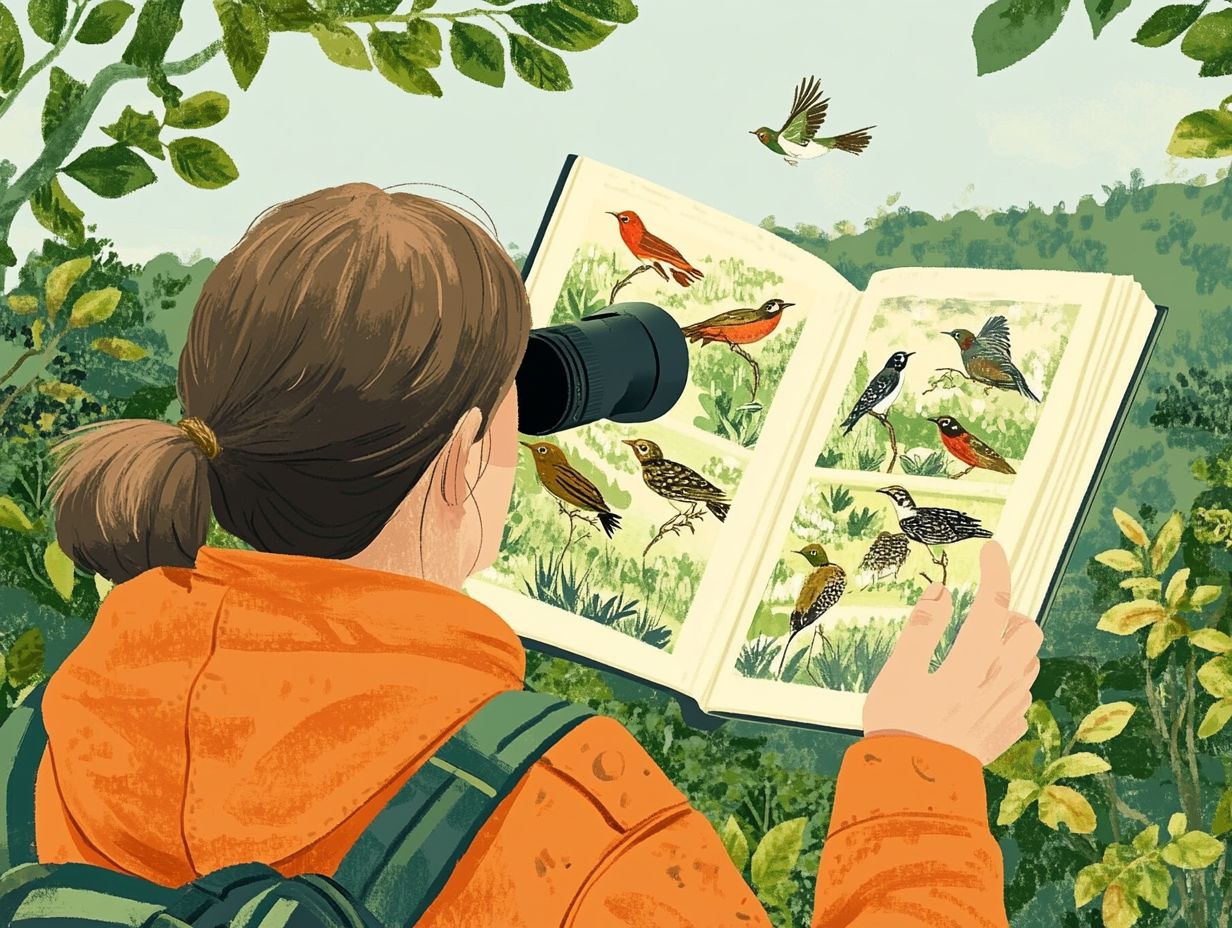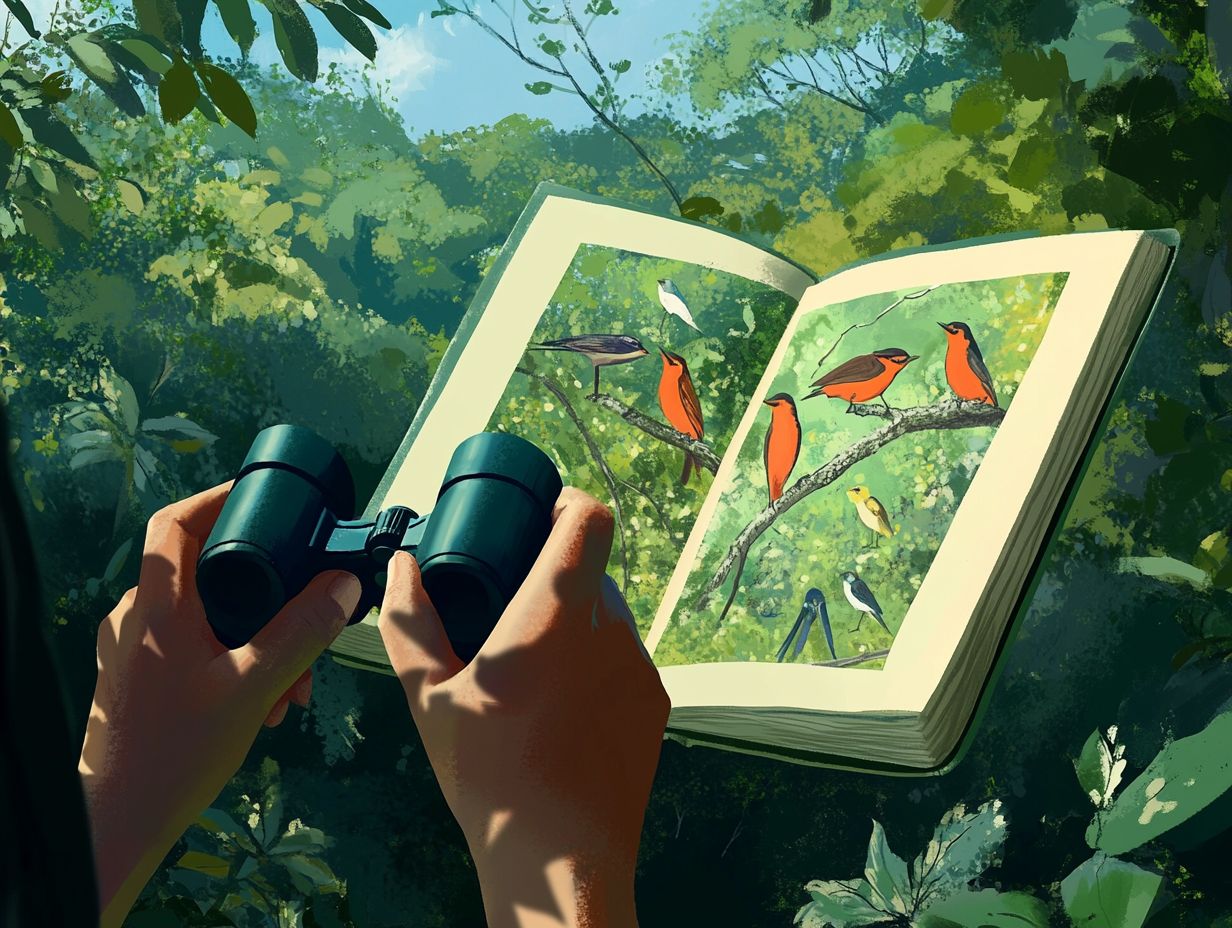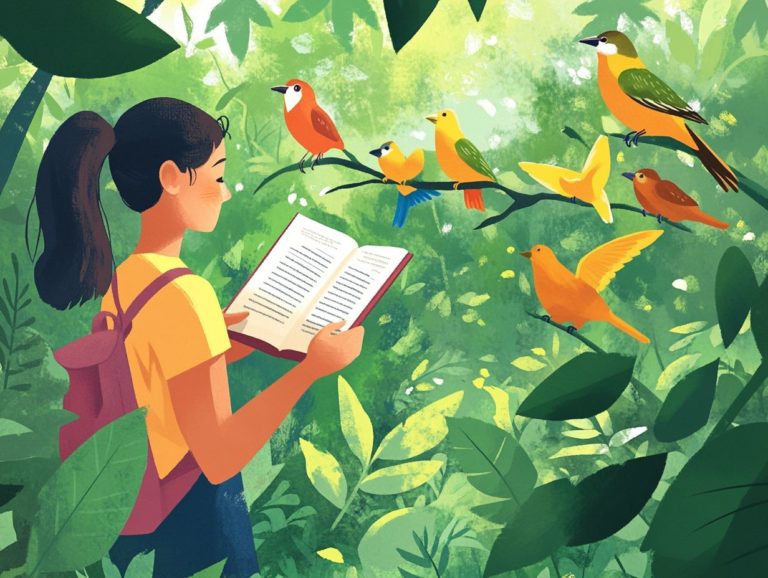Field Guides: A Beginner’s Guide to Birdwatching
Birdwatching, also known as birding, is a captivating hobby that lets you connect with nature. You’ll experience the thrill of discovering various bird species.
Whether you re a beginner or have years of experience, knowing the right equipment, identification tips, and ideal locations can enhance your experience.
This guide is your gateway to the exciting world of birdwatching! From choosing binoculars like the Nikon Monarch M5 to respecting wildlife, you ll learn how to document your observations and engage with the vibrant birding community.
Explore the captivating world of birdwatching today!
Contents
Key Takeaways:

- Invest in quality binoculars and essential gear for birdwatching. It can greatly enhance your experience and help you identify birds accurately.
- Respect birds and their habitats by following guidelines like avoiding nesting areas.
- Join birding clubs and participate in citizen science projects to enhance your skills and contribute to research. Get involved in the birding community!
What is Birdwatching?
Birdwatching, often called birding, invites you to observe and identify various bird species in their natural habitats. This engaging activity takes you into fields, forests, and wetlands.
With roots in the Victorian era, birdwatching is now a cherished pastime for many. Spotting a rare species or witnessing unique behaviors fosters appreciation for wildlife and inspires conservation efforts.
Identifying species like the majestic bald eagle or the enchanting hummingbird connects you to your surroundings. It also enriches your understanding of ecosystems.
Modern tools, like binoculars and apps, make it easier than ever to immerse yourself in the bird world. Local birdwatching groups and online communities offer invaluable support and camaraderie among fellow enthusiasts.
Essential Equipment for Birdwatching
To embark on birdwatching, having the right equipment is crucial. It can elevate your experience and boost your chances of spotting various bird species.
A high-quality pair of binoculars, like the Nikon Monarch M5, allows for intimate observation of birds with minimal disturbance. Pair these with field guides or mobile apps to enhance your identification skills.
Investing in top-notch gear enriches your birding adventures and nurtures a deeper appreciation for diverse bird life across North America, including species like the cardinal and others in the finch family.
Binoculars and Other Gear
Binoculars are arguably the most essential piece of equipment for any serious birdwatcher. They allow you to enjoy clear, close-up views of birds in their natural habitats. Models like the Nikon Monarch M5 stand out for their exceptional quality and durability, making them a top choice among enthusiasts.
As you explore the diverse array of binoculars available, you’ll come across a variety of specifications. These include how much closer you can see objects, field of view, and lens coatings that enhance light transmission. For example, roof prism binoculars are compact and easy to use, perfect for those who enjoy adventures on the go. In contrast, Porro prism models might offer a wider field of view but often come with a bulkier design.
Investing in field guides: navigating the world of birds will elevate your birdwatching experience. They allow you to confidently identify various species. If you’re keen on capturing fleeting moments, photography gear, such as camera adapters for binoculars or even using mobile apps like Merlin or Bird ID, can help you document your findings.
Don t forget about accessories like neck straps and carrying cases; they ensure comfort and convenience during your outdoor excursions.
Identifying Birds in the Field
Identifying birds in the field is an exhilarating aspect of birdwatching. It allows you to connect with nature and deepen your understanding of the diverse avian species that grace North America.
By using field guides like the Sibley Guide or the Golden Guide, you can master the art of recognizing various species through their distinctive features, calls, and behaviors. Exploring resources such as field guides: building your birdwatching knowledge enhances your enjoyment of birding and plays a crucial role in the conservation of these remarkable creatures.
Bird identification is exciting! It requires patience, sharp observation skills, and a genuine desire to learn. This transforms it into a rewarding experience for both newcomers and seasoned bird enthusiasts alike.
Common Field Guide Features

Common features found in field guides, like the Sibley Guide, are essential for improving your bird identification skills and enhancing your overall birdwatching experience, especially in North America.
These guides provide meticulously crafted illustrations that present accurate depictions of various bird species. This enables you to visually match the birds you encounter in the wild. Additionally, field guides offer invaluable insights into the habitats of different species, indicating where you’re likely to spot them during specific seasons.
Identification tips, often paired with details on bird calls and behaviors, help both novice and seasoned birders distinguish between similar-looking species with ease. By utilizing these features, you can significantly refine your observational skills and cultivate a deeper connection with the avian world.
Where to Go Birdwatching
Finding the best locations for birdwatching can truly enhance your experience. Certain areas attract a diverse array of species during specific seasons, making North America a premier destination for enthusiasts like you.
Whether you re visiting a local park with a charming bird feeder, a platform feeder, a serene nature reserve, or a picturesque wetland, each spot presents unique opportunities to observe a variety of avian species.
The changing seasons play a crucial role in bird movements. Migration patterns reveal different species at various times of the year. By exploring diverse habitats and understanding the nuances of seasonal dynamics, you can enhance your outings and significantly improve your chances of unforgettable sightings, particularly in North America.
Get ready to explore the amazing world of birdwatching! Equip yourself with the right gear and gain insights from field guides that bridge knowledge gaps in birding, and enjoy every moment in nature.
Best Locations and Seasons
Get ready for an unforgettable birdwatching adventure! The finest birdwatching locations across North America are a tapestry of diverse ecosystems. These areas transform into vibrant hotspots during specific seasons, thanks to migration patterns.
Imagine standing in the coastal marshes of Florida or wandering through the towering forests of California. Remarkable bird species flock to these areas at different times of the year. For instance, the Everglades come alive in spring migration, with countless shorebirds and songbirds painting the skies. In contrast, the lush landscapes of the Pacific Northwest reveal a breathtaking array of raptors in the fall as they embark on their southward journey.
Each destination offers unique features, from varied ecosystems to rich local flora, enticing bird populations and creating ideal viewing opportunities. Knowing when birds migrate helps you witness nature’s display in all its glory.
Do’s and Don’ts for Birdwatching
Practicing proper do’s and don’ts is crucial for you as a birdwatcher. It ensures a respectful and sustainable interaction with wildlife and their habitats, which is essential for the conservation of bird species.
Understanding the importance of keeping a safe distance from birds, especially during nesting seasons, helps minimize stress on bird populations. Be mindful of your noise levels and avoid disturbances. This way, both seasoned birdwatchers and newcomers can enjoy the beauty of nature responsibly.
By applying these principles, you actively contribute to the conservation of bird species and their ecosystems while enriching your own birdwatching experiences.
Respecting the Birds and Their Habitat
Respecting birds and their habitats is a fundamental principle of birdwatching. This ensures that these magnificent creatures can thrive in their natural environments.
This respect translates into meaningful actions that benefit not just the birds but entire ecosystems. For example, sticking to marked trails minimizes the risk of trampling delicate ground-nesting areas that many species, including the Lemon-bellied Flycatcher, rely on.
Avoid littering; debris and waste can harm wildlife and disrupt their feeding habits. Observing birds from a safe distance reduces stress in their daily routines. Using binoculars allows for intimate viewing without intrusion, protecting both the birds and their habitats.
This practice reinforces the need for conscientious behavior among all who share a love for nature.
Recording Your Observations

Recording your observations while birdwatching is a truly rewarding endeavor. It enables you to track your encounters and refine your identification skills over time. Maintaining a birding journal or checklist not only aids in recalling the species you’ve spotted but also enriches the birding community with valuable data.
By meticulously documenting details such as location, date, and behaviors, you can reflect on your experiences and share insights with fellow enthusiasts. This deepens your appreciation for the study of birds and the exquisite beauty of avian life.
Keeping a Birding Journal or Checklist
Keeping a birding journal or checklist is essential for your journey as a birdwatcher. It helps you organize your observations and deepens your connection to this rewarding activity.
This practice sharpens your identification skills and serves as a valuable resource for local bird conservation efforts. By diligently recording details such as sighting locations, weather conditions, and behavioral notes, you can uncover patterns in bird distribution and migration.
Consider creating separate sections for various habitats and using shorthand codes for quick entries. Sharing your findings with community databases enhances collective knowledge, allowing your observations to contribute to a broader understanding of local ecosystems.
Ultimately, your birding journal becomes both a personal memoir and a significant tool for ecological engagement.
So, start your birdwatching journey today, and don t forget to document your findings!
Getting Involved in the Birding Community
Engaging with the birding community offers a rewarding avenue to enrich your passion for birdwatching while connecting with fellow enthusiasts who share your interests. By joining local birding clubs and participating in citizen science projects, you can share your observations, learn from seasoned birdwatchers, and contribute to significant research efforts.
Engaging in community events, workshops, and online platforms creates a sense of belonging, enhancing your overall birding experience. It transforms your individual observations into collaborative conservation efforts that ultimately benefit avian populations across the globe.
Joining Clubs and Participating in Citizen Science Projects
Joining birding clubs and participating in citizen science projects offer you exceptional opportunities to deepen your knowledge and actively contribute to avian conservation efforts.
These organizations offer valuable resources, including access to expert-led workshops and a wealth of educational materials. They cultivate a vibrant community where you can share your experiences and discoveries with like-minded individuals.
Through these networking opportunities, you can connect with seasoned bird experts and fellow enthusiasts, fostering a spirit of collaboration that enhances your birdwatching experience. Join exciting initiatives like the Great Backyard Bird Count or eBird to make a real difference! These initiatives provide vital data that aids in tracking migration patterns and species populations.
These projects not only support scientific research but also deepen your personal connection to the avian world, making your birdwatching journey all the more enriching.
Frequently Asked Questions
What is a field guide?

A field guide is a book or resource that contains information and illustrations of different species of birds, often used by birdwatchers to identify and learn about various birds in the wild.
Why should I use a field guide for birdwatching?
A field guide is a handy tool for beginner birdwatchers, helping them identify birds and understand their behaviors. It can also enhance your overall birdwatching experience by allowing you to learn more about the birds you observe in their natural environment.
Are all field guides the same?
No, many types of field guides are available, each with their own unique features and information. Some may focus on specific regions or bird families, while others may include more detailed illustrations or photographs.
How do I choose the right field guide for me?
Consider what type of birds you are most interested in observing, as well as your level of experience and budget. Research different field guides essential for every birdwatcher and read reviews to find one that suits your needs and preferences.
Can I use a field guide on my phone or tablet?
Yes, many digital field guides are available for smartphones and tablets that can be convenient and easy to use while out in the field. However, some may prefer traditional paper field guides for a more tactile experience.
Do I need to be an expert on birds to use a field guide?
No, field guides are designed for all levels of birdwatchers. They provide information and resources to help beginners learn about different bird species and enhance their skills in the art of birdwatching.
So, dive in! Join a club or a project today!






